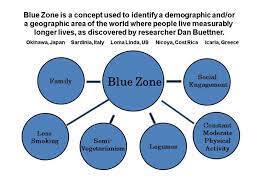

Chronic diseases are becoming more and more common in old age.
While genetics somewhat determine your lifespan and susceptibility to these diseases, your lifestyle probably has a greater impact.
A few places in the world are called “Blue Zones.” The term refers to geographic areas in which people have low rates of chronic disease and live longer than anywhere else.
This article describes the common lifestyle features of people in Blue Zones, including why they live longer.
What Are Blue Zones?
“Blue Zone” is a non-scientific term given to geographic regions that are home to some of the world’s oldest people.
It was first used by the author Dan Buettner, who was studying areas of the world in which people live exceptionally long lives.
They are called Blue Zones because when Buettner and his colleagues were searching for these areas, they drew blue circles around them on a map.
In his book called The Blue Zones, Buettner described five known Blue Zones:
Icaria (Greece): Icaria is an island in Greece where people eat a Mediterranean diet rich in olive oil, red wine and homegrown vegetables.
Ogliastra, Sardinia (Italy): The Ogliastra region of Sardinia is home to some of the oldest men in the world. They live in mountainous regions where they typically work on farms and drink lots of red wine.
Okinawa (Japan): Okinawa is home to the world’s oldest women, who eat a lot of soy-based foods and practice tai chi, a meditative form of exercise.
Nicoya Peninsula (Costa Rica): The Nicoyan diet is based around beans and corn tortillas. The people of this area regularly perform physical jobs into old age and have a sense of life purpose known as “plan de vida.”
The Seventh-day Adventists in Loma Linda, California (USA): The Seventh-day Adventists are a very religious group of people. They’re strict vegetarians and live in tight-knit communities.
Although these are the only areas discussed in Buettner’s book, there may be unidentified areas in the world that could also be Blue Zones.
A number of studies have found that these areas contain extremely high rates of nonagenarians and centenarians, which are people who live over 90 and 100, respectively.
Interestingly, genetics probably only account for 20–30% of longevity. Therefore, environmental influences, including diet and lifestyle, play a huge role in determining your lifespan.
Below are some of the diet and lifestyle factors that are common to people who live in Blue Zones.
People Who Live in Blue Zones Eat a Diet Full of Whole Plant Foods
One thing common to Blue Zones is that those who live there primarily eat a 95% plant-based diet.
Although most groups are not strict vegetarians, they only tend to eat meat around five times per month.
A number of studies, including one in over half a million people, have shown that avoiding meat can significantly reduce the risk of death from heart disease, cancer and a number of other different causes.
Instead, diets in the Blue Zones are typically rich in the following:
Vegetables: They’re a great source of fiber and many different vitamins and minerals. Eating more than five servings of fruits and vegetables a day can significantly reduce your risk of heart disease, cancer and death (11Trusted Source).
Legumes: Legumes include beans, peas, lentils and chickpeas, and they are all rich in fiber and protein. A number of studies have shown that eating legumes is associated with lower mortality.
Whole grains: Whole grains are also rich in fiber. A high intake of whole grains can reduce blood pressure and is associated with reduced colorectal cancer and death from heart disease .
Nuts: Nuts are great sources of fiber, protein and polyunsaturated and monounsaturated fats. Combined with a healthy diet, they’re associated with reduced mortality and may even help reverse metabolic syndrome (18Trusted Source, 19Trusted Source, 20Trusted Source).
There are some other dietary factors that define each of the Blue Zones.
For example, fish is often eaten in Icaria and Sardinia. It is a good source of omega-3 fats, which are important for heart and brain health.
Eating fish is associated with slower brain decline in old age and reduced heart disease
They Fast and Follow the 80% Rule
Other habits common to the Blue Zones are a reduced calorie intake and fasting.
Calorie Restriction
Long-term calorie restriction may help longevity.
A large, 25-year study in monkeys found that eating 30% fewer calories than normal led to a significantly longer life.
Eating fewer calories may be contributing to the longer lives in some of the Blue Zones.
For example, studies in the Okinawans suggest that before the 1960s, they were in a calorie deficit, meaning that they were eating fewer calories than they required, which may be contributing to their longevity.
Furthermore, Okinawans tend to follow the 80% rule, which they call “hara hachi bu.” This means that they stop eating when they feel 80% full, rather than 100% full.
This prevents them from eating too many calories, which can lead to weight gain and chronic disease.
A number of studies have also shown that eating slowly can reduce hunger and increase feelings of fullness, compared to eating rapidly.
This may be because the hormones that make you feel full only reach their maximum blood levels 20 minutes after you eat.
Therefore, by eating slowly and only until you feel 80% full, you may eat fewer calories and feel full longer.
Fasting
In addition to consistently reducing overall calorie intake, periodic fasting appears to be beneficial for health.
For example, Icarians are typically Greek Orthodox Christians, a religious group that has many periods of fasting for religious holidays throughout the year.
One study showed that during these religious holidays, fasting led to lower blood cholesterol and lower body mass index.
Many other types of fasting have also been shown to reduce weight, blood pressure, cholesterol and many other risk factors for chronic disease in humans.
These include intermittent fasting, which involves fasting for certain hours of the day or certain days of the week, and fasting mimicking, which involves fasting for a few consecutive days per month.
Posted by Nutrition
James Eckburg
